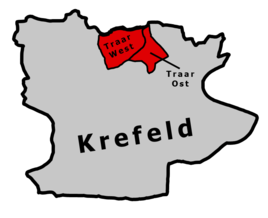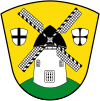Traar
|
Traar
City of Krefeld
|
|
|---|---|
| Coordinates: 51 ° 22 ′ 40 " N , 6 ° 35 ′ 50" E | |
| Height : | 32 m |
| Area : | 9.06 km² |
| Residents : | 4570 (December 31, 2011) |
| Population density : | 504 inhabitants / km² |
| Incorporation : | August 1, 1929 |
| Incorporated into: | Krefeld-Uerdingen on the Rhine |
| Postal code : | 47802 |
| Area code : | 02151 |
|
Location of Traar in Krefeld
|
|
Traar is a district of Krefeld in North Rhine-Westphalia .
Traar has 4,572 inhabitants (as of December 31, 2016, according to the population statistics of the city of Krefeld) on a total area of 906 hectares .
geography
Traar is located on the northern edge of Krefeld in the middle of an agricultural landscape typical of the Lower Rhine.
To the west, Traar borders on the Niepkuhlen , a swampy lowland formed from an oxbow lake of the Rhine, which today forms a valuable natural biotope.
In the north of Traar lies the Egelsberg , which at 46 meters above sea level is around 20 meters higher than the town center. The southern part of the mountain is partially built up and is home to a sports airfield, the Krefeld-Egelsberg airfield . The northern part is under nature protection, as the rare grasses growing there provide nesting opportunities for endangered ground-breeders.
history
The first documentary mention comes from the year 1255. Albertus de Are, named after his residence, the House of Are , was a witness to a legal act by the Archbishop of Cologne , who was in Uerdingen in 1255 . The spelling Traar developed over the spellings Are, Aere, Ahr, ter Are and Terar, which was finally established by decree in 1886.
Until 1817, Traar belonged to the Rath Honorship and then formed a mayors' association with the Honors Vennickel, Verberg , Oppum and Bockum . In 1837 the Rath and Vennikel honors were merged to form the Rath-Vennickel community, which was renamed Traar in 1886 . In 1907 Traar became an independent mayor's office. In the course of the law on the municipal reorganization of the Rhenish-Westphalian industrial area , the mayor's office in Traar was incorporated into Krefeld in 1929, despite clear protests. The town hall, built in 1914, testifies to the former, brief independence of the place and now serves as a district administration office.
The Catholic Church of St. Joseph was consecrated in 1834. In 2005 it was dissolved as an independent parish and incorporated into the new parish of Saint Christophorus in the diocese of Aachen . In 2011 the completely renovated Gertrudis Chapel, attached to the rear of the church, was inaugurated. The ensemble of the Traar church square with a large forecourt, the gardens and several buildings of the parish from the 19th century is a listed building .
The church of the Protestant Thomas Parish has existed since 1957. A new building for the community center was built in 2013.
In the garden of the Maria Schutz retirement home there is a Byzantine church owned by the Catholic Church, which is used by the Ukrainian-Greek Catholic community .
Today the town hall borders the village center with shops and apartments. The oldest building in Traar is the Haus Traar of the same name , which was owned by the Teutonic Order for a long time and from which the current name of the place is derived.
Joseph Deutsch (1885–1966), librarian and head of the university libraries in Greifswald, Breslau and Heidelberg, was born in Rath-Vennickel.
Landmark
The town's landmark is the Egelsbergmühle , one of two mills in town. It also adorns the town's coat of arms, which also includes two smaller coats of arms, which indicate that it belongs to Kurköln and that Haus Traar was donated to the Teutonic Knights Order. The mill came under heavy fire during World War II , with the impeller and facade being badly damaged. The mill has largely been restored. An original grinder was installed inside. The ground floor is used for events.
Today the Elfrather Mühle belongs to the golf club of the same name and is used as a restaurant and for events. Mies van der Rohe originally submitted a draft for the golf club's clubhouse , but it was never realized. In 2013, the design was built true to the original as part of an exhibition at Traaer Egelsberg.
coat of arms
| Blazon : "In gold (yellow) over a green mountain, a silver (white) windmill with a black roof between two small silver (white) shields, with a continuous black cross at the front and a black paw cross at the back." | |
| Reasons for the coat of arms: The coat of arms shows the Egelsbergmühle , the town's landmark on the 37 m high Egelsberg. In front you can see the Kurkölsche Cross , to which the region used to belong; in the background the cross of the Teutonic Knight Order in memory of the donation from Haus Traar . |
District Traar
In the area of the former municipality of Traar, which still exists in the cadastral system as a district of Traar, there are other districts of Krefeld besides Traar. These are the Hülser Berg , Elfrath , the northeast of Gartenstadt with the motorway entrance, and the Traar district of Vennikel with most of the Elfrather See .
societies
- Bürgererschützenverein Krefeld-Traar 1850 eV
- Citizens' Association Krefeld-Traar eV (Association for Home Care)
- FC Traar 1971 (football club)
- TV Traar 1910 (gymnastics club)
- GC Elfrather Mühle (golf club)
- TC Traar 1977 (tennis club)
- Aero Club Bayer Uerdingen (air sports club)
- VfS Krefeld (air sports club)
- Orchestervereinigung Traar eV 1925 (concert band)
- Foundation St. Josef Krefeld-Traar eV 2006 (Friends of the Catholic parish in Traar)
There are also several sailing clubs on Lake Elfrather, some of which are based in Uerdingen and others in Traar.
Traarer Platt
In Traar they speak Traarer Platt, in Krefeld they speak Krieewelsch . The city of Krefeld is located north of the so-called Benrath Line (with the maache-maake distinction ), which divides the southern Middle Franconian (also called Ripuarian ) from the northern Lower Franconian .
The “Traar dialect” is in the area of influence of another, the Uerdinger dialect line , which stretches from the Rhine via the Traar area past Hüls towards Kempen and Venlo. This Uerdinger line (also called ek-ech border ) separates the southern Lower Franconian (which is spoken in Uerdingen and Krefeld) from the northern Lower Franconian , which z. B. in Hüls (see Hölsch Plott ) and Kempen as well as the towns of the Lower Rhine north of Traar are spoken.
One of the main differences is the pronunciation of the personal pronoun " I ", which is spoken as " ech " or " isch " in Southern Lower Franconia, but as " ek " in Northern Lower Franconia . The word “also” is pronounced differently, namely as “ ook ” in the north and as “ ooch ” in the south. The verb “have” is also spoken differently: in Hüls one says z. B. "we häbbe". Further south they say “we hant”.
Since Traar (with its extensive area) is in the dialect area of influence between Uerdingen, Krefeld, Hüls and Kapellen, it has more or less pronounced similarities with these neighboring dialects - depending on which part of Traar the speaker lives in. In the Traar house and home book by Theodor and Bernd Giesbertz from 1986 (which is probably only available in second-hand bookshops), a number of dialect poems and stories are listed in which the sounds for the same word appear differently. So z. B. “I” listed once as “ek”, another time as “esch”.
Once "ek" and once "esch"
- Excerpt from the poem "Os Klieth" (by Peter Rotzen)
- On think about min Jugendtiet ("corner" instead of "I")
- then wörd et hat mesch wi-ek
- how schü-en somehow en the Klieth
- be all os Jugenstri-ek
- Excerpt from the poem "Dat Hellijehüske" (by Theo Versteegen)
- Wat ech vertell, bewongert ("ech" instead of "I")
- et wor vür Achtienhongert
- doa stung op a stien
- This Krütz, net klien.
(By the way - as the dialect author Willy Hermes writes in the above book: “Platt” has nothing to do with the “flat country”; in everyday Franconian “flat” is also the meaning for “blunt, direct” - “ek säg et dech flat vöör de Kopp! ". Platt was always the language of the people par excellence.)
See also
gallery
The mill on the Egelsberg (built in 1802)
Web links
- Citizens' Association Krefeld Traar eV
- Bürgererschützenverein Krefeld-Traar 1850 eV
- Homeland Association Traar
- Population data (PDF; 179 kB)







